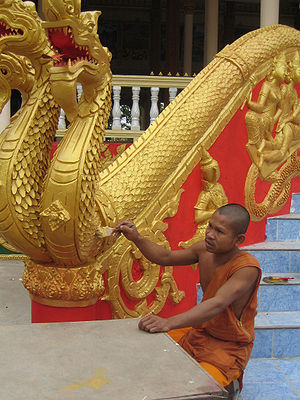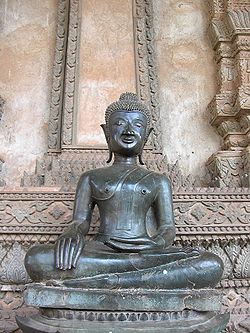
Lao Buddhist sculpture
Encyclopedia

Overview
LaoLao people
The Lao are an ethnic subgroup of Tai/Dai in Southeast Asia.-Names:The etymology of the word Lao is uncertain, although it may be related to tribes known as the Ai Lao who appear in Han Dynasty records in China and Vietnam as a people of what is now Yunan Province...
artisans have, throughout the past, used a variety of media in their sculptural creations. Of the metals, bronze
Bronze
Bronze is a metal alloy consisting primarily of copper, usually with tin as the main additive. It is hard and brittle, and it was particularly significant in antiquity, so much so that the Bronze Age was named after the metal...
is probably the most common, but gold
Gold
Gold is a chemical element with the symbol Au and an atomic number of 79. Gold is a dense, soft, shiny, malleable and ductile metal. Pure gold has a bright yellow color and luster traditionally considered attractive, which it maintains without oxidizing in air or water. Chemically, gold is a...
and silver
Silver
Silver is a metallic chemical element with the chemical symbol Ag and atomic number 47. A soft, white, lustrous transition metal, it has the highest electrical conductivity of any element and the highest thermal conductivity of any metal...
images also exist. Typically, the precious metals are used only for smaller objects, but some large images have been cast in gold, most notably the Phra Say of the sixteenth century, which the Siamese carried home as booty in the late eighteenth century. It is in enshrined at Wat Po Chai in Nongkhai, Thailand, just across the Mekong
Mekong
The Mekong is a river that runs through China, Burma, Laos, Thailand, Cambodia and Vietnam. It is the world's 10th-longest river and the 7th-longest in Asia. Its estimated length is , and it drains an area of , discharging of water annually....
River from Vientiane
Vientiane
-Geography:Vientiane is situated on a bend of the Mekong river, which forms the border with Thailand at this point.-Climate:Vientiane features a tropical wet and dry climate with a distinct monsoon season and a dry season. Vientiane’s dry season spans from November through March. April marks the...
. The Phra Say's two companion images, the Phra Seum and Phra Souk, are also in Thailand. One is in Bangkok
Bangkok
Bangkok is the capital and largest urban area city in Thailand. It is known in Thai as Krung Thep Maha Nakhon or simply Krung Thep , meaning "city of angels." The full name of Bangkok is Krung Thep Mahanakhon Amon Rattanakosin Mahintharayutthaya Mahadilok Phop Noppharat Ratchathani Burirom...
and the other is in Lopburi
Lopburi
Lopburi ) is the capital city of Lopburi Province in Thailand. It is located about 150 km north-east of Bangkok. As of 2006 it has a population of 26,500...
. Perhaps the most famous sculpture in Laos, the Phra Bang
Phra Bang
The Phra Bang ," Lao ພະ + ບາງ) is the palladium of Laos. The Lao-language name for the image has been transliterated in a number of ways, including "Pra Bang," "Prabang," "Phabang" and "Pha Bang." The statue is an 83cm-high standing Buddha with palms facing forward, cast in bronze and covered in...
, is also cast in gold, but the craftsmanship is held to be of Sinhalese, rather than Lao, origin. Tradition maintains that relics of the Buddha are contained in the image.

Copper
Copper is a chemical element with the symbol Cu and atomic number 29. It is a ductile metal with very high thermal and electrical conductivity. Pure copper is soft and malleable; an exposed surface has a reddish-orange tarnish...
, containing about two percent tin
Tin
Tin is a chemical element with the symbol Sn and atomic number 50. It is a main group metal in group 14 of the periodic table. Tin shows chemical similarity to both neighboring group 14 elements, germanium and lead and has two possible oxidation states, +2 and the slightly more stable +4...
. Other materials are often added, however, and the balance of ingredients determines the characteristics of the bronze. In Laos, like Cambodia and Thailand, the bronze, which is called samrit, includes precious metals, and often has a relatively high percentage of tin, which gives the newly-cast images a lustrous dark gray color. Other images, such as the Buddha of Vat Chantabouri in Vientiane, have a higher copper and, probably, gold content that give them a muted gold color.
A number of colossal images in bronze exist. Most notable of these are the Phra Ong Teu (16th century) of Vientiane, the Phra Ong Teu of Sam Neua, the image at Vat Chantabouri (16th century) in Vientiane and the image at Vat Manorom (14th century) in Luang Phrabang, which seems to be the oldest of the colossal sculptures. The Manorom Buddha, of which only the head and torso remain, shows that colossal bronzes were cast in parts and assembled in place.
Brick-and-mortar also seems to be a favorite medium for colossal images. Perhaps the most famous of these is the image of Phya Vat (16th century) in Vientiane, though apparently an unfortunate renovation completely altered the appearance of the sculpture, and it no longer resembles a Lao Buddha.
Wood is popular for small, votive Buddhist images that are often left in caves. Wood is also very common for large, life-size standing images of the Buddha.
The most famous two sculptures carved in semi-precious stone are the Phra Keo (The Emerald Buddha
Emerald Buddha
The Emerald Buddha is the palladium of the Kingdom of Thailand, a figurine of the sitting Buddha, made of green jadeite , clothed in gold, and about 45 cm tall...
) and the Phra Phuttha Butsavarat. The Phra Keo, which is probably of Xieng Sen (Chiang Saen
Chiang Saen
* Amphoe Chiang Saen, a district in modern Chiang Rai Province* Chiang Saen, a capital in the ancient Lanna kingdom, and the namesake of the modern district...
) origin, is carved from a solid block of jade. It rested in Vientiane for two hundred years before the Siamese carried it away as booty in the late eighteenth century. It now serves as the palladium of the Kingdom of Thailand, and resides at the Grand Palace in Bangkok. The Phra Phuttha Butsavarat, like the Phra Keo, is also enshrined in its own chapel at the Grand Palace in Bangkok. Before the Siamese seized it in the early nineteenth century, this crystal image was the palladium of the Lao kingdom of Champassack
Kingdom of Champasak
The Kingdom of Champasak , in southern Laos, broke away from the Lan Xang kingdom in 1713. The Kingdom of Champasak prospered at the beginning the 18th century, but it was reduced to a vassal state of Siam before the century had passed. Under French rule the kingdom became an administrative block...
.
Many mostly wooden Lao Buddhist sculptures have been assembled inside the Pak Ou caves
Pak Ou Caves
Near Pak Ou the Tham Ting and the Tham Theung are caves overlooking the Mekong River 25 km from Luang Prabang, Laos. They are a group of caves on the left side of the Mekong river, about two hours upstream from the centre of Luang Prabang, and have become well known by tourists...
.
Modern developments

Luang Pu Bunleua Sulilat
Bunleua Sulilat was a Thai/Isan/Lao mystic, myth-maker, spiritual cult leader and sculpture artist...
: Buddha Park
Buddha Park
Buddha Park, also known as Xieng Khuan , is a sculpture park located 25 km southeast from Vientiane, Laos in a meadow by the Mekong River. Although it is not a temple , the park may be referred to as Wat Xieng Khuan , since it contains numerous religious images...
near Vientiane
Vientiane
-Geography:Vientiane is situated on a bend of the Mekong river, which forms the border with Thailand at this point.-Climate:Vientiane features a tropical wet and dry climate with a distinct monsoon season and a dry season. Vientiane’s dry season spans from November through March. April marks the...
, and Sala Keoku
Sala Keoku
Sala Keoku is a park featuring giant fantastic concrete sculptures inspired by Buddhism and Hinduism. It is located near Nong Khai, Thailand in immediate proximity of the Thai-Lao border and the Mekong river. The park has been built by and reflects the personal vision of Luang Pu Bunleua Sulilat...
near Nong Khai
Nong Khai
Nong Khai is a city in North-East Thailand and is the capital of the Nong Khai Province...
, Thailand
Thailand
Thailand , officially the Kingdom of Thailand , formerly known as Siam , is a country located at the centre of the Indochina peninsula and Southeast Asia. It is bordered to the north by Burma and Laos, to the east by Laos and Cambodia, to the south by the Gulf of Thailand and Malaysia, and to the...
.

